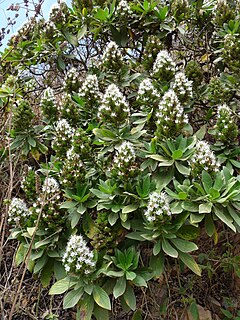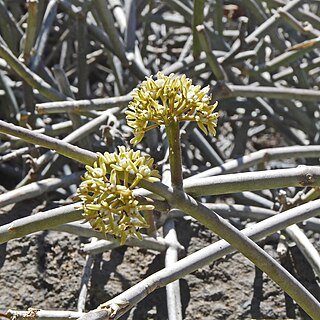
Artemisia gorgonum is a species of flowering plants of the family Asteraceae, endemic to Cape Verde. Its local name is losna or lasna. The plant plays a role in traditional medicine.

Euphorbia tuckeyana is a species of flowering plants of the family Euphorbiaceae. The species is endemic to Cape Verde. The species is named after James Hingston Tuckey. Its local name is tortolho. The plants are used for tanning hides.

Echium hypertropicum is a species of flowering plants of the family Boraginaceae. The species is endemic to Cape Verde. It is listed as an endangered plant by the IUCN.
Micromeria forbesii is a species of flowering plants of the genus Micromeria. The species is endemic to Cape Verde. It is listed as endangered by the IUCN. It was first described by George Bentham in 1834. Its local name is erva-cidreira, or cidreirinha. In traditional medicine, it is used as an infusion for the treatment of indigestion, diarrhea, cough and to stimulate labour.

Echium vulcanorum is a species of flowering plants of the family Boraginaceae. The species is endemic to Cape Verde. It is listed as an endangered plant by the IUCN. The species was first described in 1935 by Auguste Chevalier. Its local name is língua-de-vaca, a name that may also refer to the related species Echium hypertropicum and Echium stenosiphon. The oil of its seeds contains γ-linolenic acid, and is used for medicinal and dietary purposes.
Limonium jovibarba is a species of flowering plants of the family Plumbaginaceae. The species is endemic to Cape Verde. It is listed as critically endangered by the IUCN. The species was named by Carl Ernst Otto Kunze in 1891. Its local name is carqueja, a name that may also refer to the related species Limonium brunneri and Limonium braunii.
Sonchus daltonii is a species of flowering plants of the family Asteraceae. The species is endemic to Cape Verde. It is listed as endangered by the IUCN. The genus was named by Philip Barker Webb in 1849. Its local name is coroa-de-rei.
Limonium braunii is a species of flowering plants of the family Plumbaginaceae. The species is endemic to Cape Verde. It is listed as an endangered plant by the IUCN. The species was first described by the German Carl August Bolle as Statice braunii and was placed in the genus Limonium by the French Auguste Chevalier in 1935. Its local name is carqueja, a name that may also refer to the related species Limonium brunneri and Limonium jovibarba.
Limonium lobinii is a species of flowering plants of the family Plumbaginaceae. The species is endemic to Cape Verde. It is listed as an endangered species by the IUCN. The species was first described by Norbert Kilian and Teresa Leyens in 1994. Its local name is carqueja-de-Santiago.

Erysimum caboverdeanum is a species of flowering plants of the family Brassicaceae. The species is endemic to Cape Verde. It is listed as a critically endangered plant by the IUCN. The species was first described by Auguste Chevalier in 1935 as Matthiola caboverdeana; it was placed into the genus Erysimum by Per Øgle Sunding in 1974. Its local name is cravo-brabo. It is used in traditional medicine.
Conyza feae is a species of aster flowers that belong to the family Asteraceae. The species is endemic to Cape Verde. It is listed as an endangered plant by the IUCN. First described as Nidorella feae, it was placed in the genus Conyza by Hiram Wild in 1969. The specific name feae refers to the Italian naturalist Leonardo Fea. Its local name is losna-brabo or losna-bravo. The plant plays a role in traditional medicine.

Conyza varia is a species of flowering plants of the family Asteraceae. The species is endemic to Cape Verde. It is listed as an endangered plant by the IUCN. First described as Erigeron varius by Philip Barker Webb, it was placed in the genus Conyza by Hiram Wild in 1969. Its local name is marcelinha or tabua, tabuinha. The plant plays a role in traditional medicine: crushed and heated leaves are used to treat external inflammations.
Conyza pannosa is a species of flowering plants of the family Asteraceae. The species is endemic to Cape Verde. It is listed as an endangered plant by the IUCN. The plant was named by Philip Barker Webb in 1849. Its local name is taba.
Diplotaxis glauca is a species of flowering plants of the family Brassicaceae. The species is endemic to Cape Verde. It is listed as a critically endangered plant by the IUCN. The plant was named by Otto Eugen Schulz in 1916. The local name of the species is mostarda-brabo, a name that may also refer to the related species Diplotaxis gracilis.
Campanula bravensis is a species of flowering plant in the bellfower family Campanulaceae. The species is endemic to Cape Verde. The specific name bravensis refers to the island of Brava. The species was described by Carl August Bolle, and named by Auguste Chevalier in 1935. Its local name is contra-bruxas-branca.

Sarcostemma daltonii is a species of flowering plants of the family Apocynaceae. The species is endemic to Cape Verde. The specific name refers to Joseph Dalton Hooker. The species was named by Joseph Decaisne in 1849. Its local name is gestiba. The plant is used in traditional medicine to relieve and treat dental problems.
Asparagus squarrosus is a species of flowering plant in the family Asparagaceae. The species is endemic to Cape Verde. The species was named by Johann Anton Schmidt in 1853. Its local name is espargo. The plant is used in traditional medicine.
Asteriscus daltonii is a species of flowering plants of the family Asteraceae. The species is endemic to Cape Verde. Its local name is macela. It is listed as near threatened by the IUCN.
Limonium sundingii is a species of flowers that belong to the family Plumbaginaceae. The species is endemic to Cape Verde. It is listed as critically endangered by the IUCN.
Tolpis farinulosa is a species of flowering plants of the family Asteraceae. The species is endemic to Cape Verde. It is listed as endangered by the IUCN. Its local name is mato-branco, a name that may also refer to the species Phagnalon melanoleucum and Verbascum cystolithicum.







